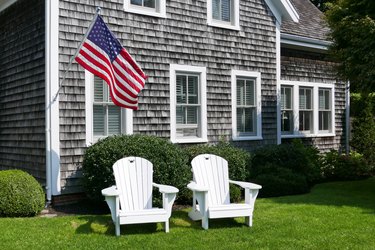
When you care enough about a flag's meaning to put it on display, you hate to come outside and find that it's all balled up on the pole ... again. Even a lightly windy day can send your flag flying in such a way that it ends up furled, or wrapped around itself on the flagpole. There are a few simple ways to stabilize your flag so you don't have to wrestle with it every time a breeze blows. Experiment with one or more of them to find the solution that works for your specific setup.
1. Switch to a Rotating Flagpole
Video of the Day
Traditional poles are made of a single, stationary piece of galvanized metal pipe, which makes a stable base for a flag to get wrapped around. A wind that's blowing in one direction will send the flag around and around the pole. The friction of the fabric will help it stay tangled on the pole even when the wind subsides.
Video of the Day
Switching to a rotating flagpole prevents the flag from becoming wrapped around itself. Different models are designed in slightly different ways, but a rotating flagpole is often composed of a stationary pole with a second piece that slides over the pole and attaches to the flag. The stationary piece is attached to the ground or bracketed to your house while the second piece is free to rotate around the pole. As the wind blows the flag in one direction or the other, that rotating piece should keep it from furling around the pole.
2. Attach Anti-Wrap Rings
Rather than buying a new pole, another option is to add anti-wrap mounting rings to an existing pole. Screw two rings onto the pole and connect the flag to the clips attached to each ring. The rings should freely spin with the flag's movements so no wrapping occurs. Rings come in different colors and finishes that blend in with your flagpole.
3. Weight the Flag
In some cases, it's easier to address the flag itself rather than trying to alter your pole, especially if you're working with a 20-foot pole that's already properly strung and ready to use. Making the flag heavier should keep it more stable so it doesn't start to wrap around the flagpole in every light wind.
One option is to look for a new flag that's made of a heavier fabric than your current version, but it's easier to try attaching magnetic weights to the lower-right corner of the flag. These weights are often sold in red so they blend in with the red stripes on the American flag. Sandwich a pair of magnets on either side of the flag fabric or use a few pairs. Weighting the edge of the flag that's farthest from the flagpole limits how much the flag will move in the wind. Using magnetic weights is also a good strategy to control furling if you display two flags on one pole.
Another kind of product, called a flag weight, is appropriate for use with a vertical flagpole. It's a small weight that hangs from the bottom left corner of the flag to keep the flag close to the pole and prevents wrapping.
4. Stabilize the Flag
A product called a flag stabilizer rod may be useful if you want your flag to stay as still as possible. It's a metal rod that connects to the lower edge of the flag and keeps it straight. Even if the wind blows the flag forcefully around its pole, the bottom of the flag won't furl.